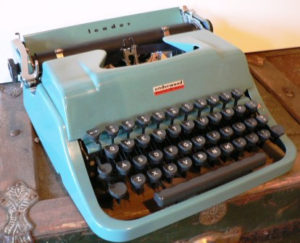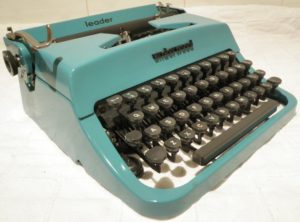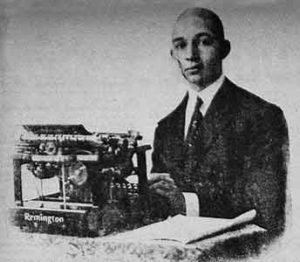FIRST TYPEWRITERS USED IN CUBA. COMPETITIONS AND AWARDS.
In Cuba the typewriters that until today are still used were born in the United States in 1872; Were its inventors the engineers Byron, Brooks, Densmore, Fenne, Sholes and Yost. He was given the name of Remington in memory of the workshops where the initial models were built. Of course, all this opens the way to computers that begin to form part of the slow progress of modern writing in Cuba.
Cubans, in the last century, always kept their arms open to all innovations. Examining ancient documents the curious finds a series of details that speak highly of the progressive spirit of the Cubans even from the colony. Refrigerators, for example, were imported into Havana a few months after they were put up for sale in New York.
The same thing happened with the typewriter. In the records of the year 1887 of the Council of Administration of the Island of Cuba, we have found reports rendered by Dr. Antonio González de Mendoza, Adviser of Administration, typewritten, with a cleaning of execution that lack some typists of today. Without being able to assure it in an absolute way, all the data we have read and collected allow us to believe that it was the lawyer who imported the first such machine in Cuba and it is notable that the first one was placed on the American market, as we have said , In 1872 and that the documents that we have seen in the National Archive belong to 1887, that is fifteen years later.
Typing in the 1900s.
The typewriter, at the beginning of the twentieth century, was already consecrated as an instrument of a new office with borders of art. The first and then the Republic Government, with the natural bureaucratic expansion imposed by reorganization and expansion of public services, offered wide field to typists and, in the year 1909, the need was so felt that the Provincial Institute of La Habana had a chair of Shorthand and Typing that was in charge of Mr. Frank A. Betancourt.
This creole, somewhat intellectual and a little adventurous, had been secretary of the Guatemalan Minister in Washington and, assured his panegyrists of the time, was the first Cuban who studied shorthand and typing in the United States.
He held the same chair in Buenos Aires as in Cuba, in the commercial schools, and won a prize in the International Exhibition of San Luis with a work on shorthand. In the year 1900 he entered the history of our teaching by founding an academy in the city of Santiago de Cuba.

” Frank A. Betancourt, the first Cuban who studied typing in the United States and who, in 1909, was Professor of Shorthand, Mechanization and Mecanostrography at the Provincial Institute of Havana.
The First Contest.
At the beginning of October 1909, the Provincial Institute of Havana called the first contest of typing in Cuba. Only the students of that school could take part in it and had as object to reward the one that better and faster to translate in a machine a shorthand dictation and to choose the champion of resistance, declaring itself triumphant to that more words wrote, with fewer faults, during two hours Of dictation.
Both competitions attended almost all the students enrolled in the two courses that comprised the subject.
In practice, the competition was split between the students of each course. In the first, won the championship Miss Havana Church; Miss Carmen Rodríguez the second prize and Romualda Hernandez the third.

Group of students who won prizes in the contest referred to in this work. Included are the numerous accésits granted in both courses.
Among those of the upper course the first prize was awarded to the young Lorenzo A. Betancourt, following in order Maria Teresa Baliarda and Angela Hernández.
The prizes consisted of gold and silver medals, donated by representatives of the North American houses that disputed the growing market of Havana.
The Cuban women who launched themselves to learn typing at that time were the pioneers of those thousands of charming ladies who today fill the public and private offices of the country. As can be seen from the photos that have come to us, almost all of the prizes were won by them despite the long skirts, annoying sleeves, monumental hairstyles and the inseparable chaperone to go and return to class.
PRIMERAS MÁQUINAS DE ESCRIBIR USADAS EN CUBA. CONCURSOS Y PREMIOS.
En Cuba las máquinas de escribir que hasta hoy se siguen utilizando nacieron en los Estados Unidos en 1872; fueron sus inventores los ingenieros Byron, Brooks, Densmore, Fenne, Sholes y Yost. Se le dió el nombre de Rémington en recuerdo de los talleres donde se construyeron los modelos iniciales. Por supuesto que todo esto abre paso a las computadoras que comienzan a formar parte del lento adelanto de la escritura moderna en Cuba.
Los cubanos, en el pasado siglo, mantuvieron siempre los brazos abiertos a todas las innovaciones. Examinando documentos antiguos encuentra el curioso una serie de detalles que hablan muy alto del espíritu progresista de los cubanos aun desde la colonia. Las neveras, por ejemplo, fueron importadas en La Habana pocos meses después de haber sido puestas a la venta en Nueva York.
Lo mismo sucedió con la máquina de escribir. En los expedientes del año de 1887 del Consejo de Administración de la Isla de Cuba, hemos encontrado informes rendidos por el doctor Antonio González de Mendoza, Consejero de Administración, escritos a máquina, con una limpieza de ejecución de que carecen algunos mecanógrafos de hoy. Sin que podamos asegurarlo de un modo absoluto, todos los datos que hemos leído y recogido permiten creer que fué dicho letrado quien importó la primera máquina de ese tipo en Cuba y es notable comprobar que la primera fué puesta en el mercado americano, según dejamos dicho, en 1872 y que los documentos que hemos visto en el Archivo Nacional pertenecen a 1887, es decir quince años después.
La Mecanografía en años 1900s.
La máquina de escribir, al iniciarse el siglo XX, Estaba ya consagrada como instrumento de un nuevo oficio con ribetes de arte. El Gobierno Interventor primero, y la República después, con la natural expansión burocrática impuesta por reorganización y ampliación de los servicios públicos, ofrecieron amplio campo a los mecanógrafos y, en el año de 1909, la necesidad era tan sentida que el Instituto Provincial de La Habana contaba con una cátedra de Taquigrafía y Mecanografía que estaba a cargo del señor Frank A. Betancourt.

Frank A. Betancourt, el primer cubano que estudió mecanografía en los Estados Unidos y que, en 1909, era catedrático titular de Taquigrafía, Mecanografía y Mecanostenografía en el Instituto Provincial de La Habana.
Este criollo, un poco intelectual y un poco aventurero, había sido secretario del Ministro de Guatemala en Wáshington y, aseguran sus panegiristas de la época, fué el primer cubano que estudió taquigrafía y mecanografía en los Estados Unidos.
Desempeñó en Buenos Aires la misma cátedra que en Cuba, en las escuelas comerciales, y ganó un premio en la Exposición Internacional de San Luis con una obra sobre taquigrafía. En el año de 1900 entró en la historia de nuestra enseñanza fundando una academia en la ciudad de Santiago de Cuba.
Primeros Concursos.
A principios del mes de octubre año 1909, el Instituto Provincial de La Habana convocó al primer concurso de mecanografía efectuado en Cuba. Sólo podían tomar parte en él los alumnos del citado plantel y tenía por objeto premiar al que mejor y más rápidamente tradujera en máquina un dictado taquigráfico y escoger el campeón de resistencia, declarándose triunfador al que más palabras escribiera, con menos faltas, durante dos horas de dictado.

Señorita Habana Iglesia, campeón del primer curso en el primer concurso taquígrafo-mecanográfico convocado en Cuba. Sara Garbiras Sánchez Agramonte, campeón del concurso de resistencia convocado por el Instituto de La Habana en 1909. Escribió 3,400 palabras en 2 horas.
A ambos concursos concurrieron casi todos los alumnos matriculados en los dos cursos de que constaba la asignatura.
En la práctica el concurso se desdobló efectuándose separadamente entre los alumnos de cada curso. En el primero, obtuvo el campeonato la señorita Havana Iglesia; la señorita Carmen Rodríguez el segundo premio y Romualda Hernández el tercero.
Entre los del curso superior el primer premio fué adjudicado al joven Lorenzo A. Betancourt, siguiéndole en orden María Teresa Baliarda y Angela Hernández.
Los premios consistieron en medallas de oro y plata, donadas por los representantes de las casas norteamericanas que se disputaban el creciente mercado de La Habana.
Las cubanitas que se lanzaron al aprendizaje de la mecanografía en aquella oportunidad fueron las pioneras de esos millares de encantadoras damitas que llenan hoy las oficinas públicas y privadas del país. Como se desprende de las fotos que han llegado hasta nosotros la casi totalidad de los premios fueron acaparados por ellas a pesar de las faldas largas, las mangas molestas, los peinados monumentales y la inseparable chaperona para ir y volver de clases.
Agencies/Bohemia1952/Extractos/Internet Photos/ Arnoldo Varona/ TheCubanHistory.com
THE CUBAN HISTORY, HOLLYWOOD.



 FIRST TYPEWRITERS used in Cuba. Competitions and Awards. + PRIMERAS MÁQUINAS de Escribir usadas en Cuba. Concursos y Premios.
FIRST TYPEWRITERS used in Cuba. Competitions and Awards. + PRIMERAS MÁQUINAS de Escribir usadas en Cuba. Concursos y Premios.




